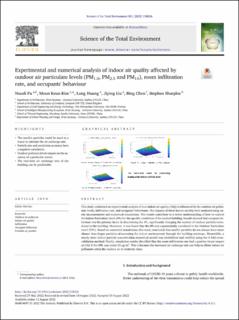| dc.contributor.author | Fu, Nuodi | |
| dc.contributor.author | Kim, Moon Keun | |
| dc.contributor.author | Huang, Long | |
| dc.contributor.author | Liu, Jiying | |
| dc.contributor.author | Chen, Bing | |
| dc.contributor.author | Sharples, Stephen | |
| dc.date.accessioned | 2022-12-22T15:26:34Z | |
| dc.date.available | 2022-12-22T15:26:34Z | |
| dc.date.created | 2022-11-09T13:02:24Z | |
| dc.date.issued | 2022-09-01 | |
| dc.identifier.citation | Science of the Total Environment. 2022, 851 . | en_US |
| dc.identifier.issn | 0048-9697 | |
| dc.identifier.issn | 1879-1026 | |
| dc.identifier.uri | https://hdl.handle.net/11250/3039289 | |
| dc.description.abstract | This study conducted an experimental analysis of how indoor air quality (IAQ) is influenced by the outdoor air pollutants levels, infiltration rate, and occupants' behaviours. The impacts of these factors on IAQ were analyzed using on-site measurements and numerical simulations. The results contribute to a better understanding of how to control the Indoor Particulate Level (IPL) for the specific conditions of the studied building. Results showed that occupant behaviour was the primary factor in determining the IPL, significantly changing the number of outdoor particles introduced to the building. Moreover, it was found that the IPL was exponentially correlated to the Outdoor Particulate Level (OPL). Based on numerical simulations, this study concluded that smaller particles do not always have more chance than larger particles of accessing the indoor environment through the building envelope. Meanwhile, a steady-state indoor particle concentration numerical model was established and verified using the 4-fold cross-validation method. Finally, simulation results identified that the room infiltration rate had a positive linear impact on IAQ if the OPL was under 30 μg/m3 . This is because the increased air exchange rate can help to dilute indoor air pollutants when the outdoor air is relatively clean. | en_US |
| dc.language.iso | eng | en_US |
| dc.publisher | Elsevier | en_US |
| dc.relation.ispartofseries | Science of the Total Environment;Volume 851, Part 2, 10 December 2022, 158026 | |
| dc.rights | Navngivelse 4.0 Internasjonal | * |
| dc.rights.uri | http://creativecommons.org/licenses/by/4.0/deed.no | * |
| dc.subject | Outdoor air pollution | en_US |
| dc.subject | Indoor air quality | en_US |
| dc.subject | Infiltration | en_US |
| dc.subject | Occupant behaviour | en_US |
| dc.subject | Portable air purifiers | en_US |
| dc.title | Experimental and numerical analysis of indoor air quality affected by outdoor air particulate levels (PM<inf>1.0</inf>, PM<inf>2.5</inf> and PM<inf>10</inf>), room infiltration rate, and occupants' behaviour | en_US |
| dc.type | Peer reviewed | en_US |
| dc.type | Journal article | en_US |
| dc.description.version | publishedVersion | en_US |
| dc.rights.holder | © 2022 The Authors | en_US |
| dc.source.articlenumber | 158026 | en_US |
| cristin.ispublished | true | |
| cristin.fulltext | original | |
| cristin.qualitycode | 2 | |
| dc.identifier.doi | https://doi.org/10.1016/j.scitotenv.2022.158026 | |
| dc.identifier.cristin | 2071225 | |
| dc.source.journal | Science of the Total Environment | en_US |
| dc.source.volume | 851 | en_US |
| dc.source.issue | 2 | en_US |
| dc.source.pagenumber | 1-15 | en_US |

